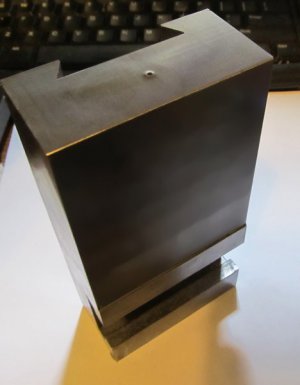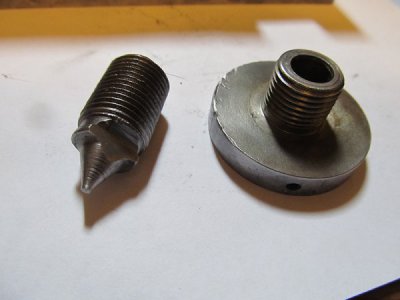- Joined
- Jul 6, 2016
- Messages
- 102
Ok its a pretty simple question, but first background:
I have an old logan 1821 that i have been restoring. the major thing wrong with it was that the compound looks like it blown up with dynamite. actually I think that someone gorilla torqued a tool holder or some such device onto it and busted out the tee slot. So at any rate I machined a new one as seen in the image below.
please realze that I understand that my machining is horrifying, but you gotta understand that this is like the 4th thing that I have ever attempted to make on a mill in my life, so I Honestly have no experience at all.
the last operation that I have to do is to bore and thread one end of the compund to receve a guide *see below* for the lead screw. I could either attempt to mound it in my little 10 inch logan 820 which scares the hell 0ut of me lol. Or I can bore it with my mill. The problem is that if i bore it with my mill i will have no way to tap it. The size of the thread is .6800 which is 17/25ths or there abouts. no way someone makes that tap. So im back to using a 10 inch lathe to mount this big chunk of metal in...... if I bore it and thread it on the lathe, it will be fine.... as long as it does not kill me in the process. I mounted it up in the 4 jaw and it felt solid. I found the dimple with a dead center in the tail stock. So I can do this.;
BUT CAN I? Is this too big for a 10 inch lathe?
By the way. the pointy set screw looking deal is a piece of gummy .6800 mild steel that I made to transfer the position of the feature on the original compound. it was some of that crap that you get from the hardware store that turns like frozen bubble gum.......
so do I attempt this or send it out to a buddy to do?


I have an old logan 1821 that i have been restoring. the major thing wrong with it was that the compound looks like it blown up with dynamite. actually I think that someone gorilla torqued a tool holder or some such device onto it and busted out the tee slot. So at any rate I machined a new one as seen in the image below.
please realze that I understand that my machining is horrifying, but you gotta understand that this is like the 4th thing that I have ever attempted to make on a mill in my life, so I Honestly have no experience at all.
the last operation that I have to do is to bore and thread one end of the compund to receve a guide *see below* for the lead screw. I could either attempt to mound it in my little 10 inch logan 820 which scares the hell 0ut of me lol. Or I can bore it with my mill. The problem is that if i bore it with my mill i will have no way to tap it. The size of the thread is .6800 which is 17/25ths or there abouts. no way someone makes that tap. So im back to using a 10 inch lathe to mount this big chunk of metal in...... if I bore it and thread it on the lathe, it will be fine.... as long as it does not kill me in the process. I mounted it up in the 4 jaw and it felt solid. I found the dimple with a dead center in the tail stock. So I can do this.;
BUT CAN I? Is this too big for a 10 inch lathe?
By the way. the pointy set screw looking deal is a piece of gummy .6800 mild steel that I made to transfer the position of the feature on the original compound. it was some of that crap that you get from the hardware store that turns like frozen bubble gum.......
so do I attempt this or send it out to a buddy to do?




